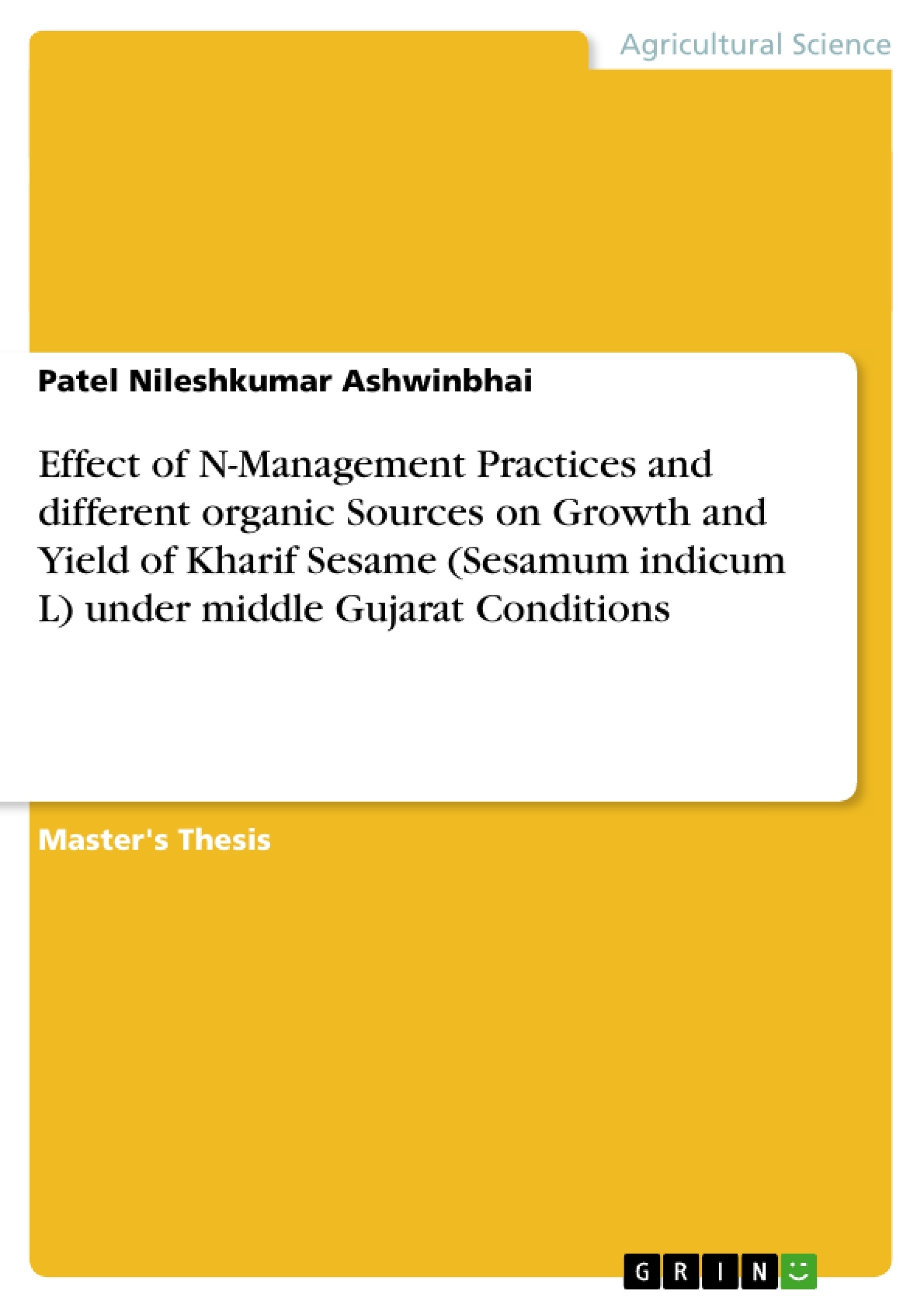The present study focus on Effect of N-management practices and different organic sources on growth and yield of kharif sesame (Sesamum indicum L.). The treatment combinations comprised consisting of application of nitrogen viz., N0 (Control), N1 (25 kg N ha-1), N2 (Azospirillum) and N3 (50 % RDN + Azospirillum) relegated to main treatment and other sub treatments comprised of application of organic manure viz., M1 (Humic acid 10 kg ha-1), M2 (Poultry Manure 500 kg ha-1) and M3 (Vermicompost 500 kg ha-1). The results revealed that treatment N3 (50 % RDN + Azospirillum) recorded significantly higher. While, treatment N2 (Azospirillum) significantly the highest harvest index. Treatment N3 (50 % RDN + Azospirillum) recorded significantly higher seed yield (479 kg ha-1) and stover yield (1960 kg ha-1) of sesame. Application of humic acid 10 kg ha-1 (M1) secured higher seed yield (444 kg ha-1) and stover yield (1716 kg ha-1).The interaction effect of nitrogen and organic manure application revealed that treatment combination N2M3 (Azospirillum along with vermicompost 500 kg ha-1) recorded significantly the highest harvest index (39.20 %), but treatment combination N3M1 (50 % RDN + Azospirillum along with humic acid 10 kg ha-1) recorded significantly the highest seed yield (580 kg ha-1).
Inhaltsverzeichnis (Table of Contents)
- Abstract
- Introduction
- Review of Literature
- Materials and Methods
- Experimental Site
- Soil Characteristics
- Treatments
- Experimental Design
- Observations
- Results and Discussion
- Effect of Nitrogen Management Practices
- Effect of Organic Sources
- Interaction Effect of Nitrogen and Organic Manure
- Summary and Conclusion
- References
Zielsetzung und Themenschwerpunkte (Objectives and Key Themes)
This study aimed to investigate the impact of nitrogen management practices and different organic sources on the growth and yield of kharif sesame (Sesamum indicum L.) under middle Gujarat conditions. The research explored the potential of various nitrogen application methods and organic amendments to optimize sesame production.- Nitrogen management strategies and their effects on sesame growth and yield
- Impact of various organic sources on sesame productivity
- Interaction effects between nitrogen application and organic amendment on sesame growth and yield
- Determination of the most effective combination of nitrogen and organic sources for maximizing sesame seed yield
- Evaluation of cost-benefit ratio (CBR) for different nitrogen and organic amendment treatments
Zusammenfassung der Kapitel (Chapter Summaries)
The study, conducted on loamy sand soil at the College Agronomy Farm, Anand Agricultural University, investigated the effects of different nitrogen management practices and organic sources on kharif sesame (Sesamum indicum L.) growth and yield. The “Materials and Methods” section details the experimental site, soil characteristics, treatments (including nitrogen application and organic manure), experimental design, and observations recorded. The “Results and Discussion” chapter focuses on analyzing the impact of different nitrogen management practices, organic sources, and their interactions on key growth parameters, yield attributes, and overall yield of sesame. It explores the effectiveness of various treatments in terms of seed yield, stover yield, harvest index, and net CBR. While the “Summary and Conclusion” chapter is not included in the preview to avoid spoilers, the study likely presents a comprehensive analysis of the most effective nitrogen and organic source combinations for achieving optimal sesame growth and yield under the specific conditions of middle Gujarat.Schlüsselwörter (Keywords)
The study explores important concepts and terms such as nitrogen management practices, organic sources, kharif sesame, growth, yield, seed yield, stover yield, harvest index, cost-benefit ratio (CBR), and middle Gujarat conditions. The research findings are likely to have implications for sustainable sesame production and improving the overall profitability of sesame farming in the region.- Quote paper
- Patel Nileshkumar Ashwinbhai (Author), 2009, Effect of N-Management Practices and different organic Sources on Growth and Yield of Kharif Sesame (Sesamum indicum L) under middle Gujarat Conditions, Munich, GRIN Verlag, https://www.grin.com/document/231161



